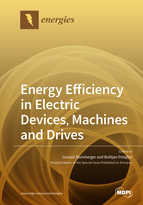Energy Efficiency in Electric Devices, Machines and Drives
A special issue of Energies (ISSN 1996-1073). This special issue belongs to the section "F: Electrical Engineering".
Deadline for manuscript submissions: closed (15 October 2019) | Viewed by 40095
Special Issue Editors
Interests: design; optimization; modeling and control of electric devices; machines, drives, and power system elements; electric power generation, transmission, and distribution; renewable energy sources and distributed generation; smart grids and microgrids; energy management systems
Special Issues, Collections and Topics in MDPI journals
Interests: electric machines and drives; electrical power quality; electrical power system protection and control
Special Issues, Collections and Topics in MDPI journals
Special Issue Information
Dear Colleagues,
At the present time, energy efficiency is one of the topics that cannot be avoided when dealing with electric devices, machines, drives, and systems. On the one hand, the products that do not achieve minimal efficiencies defined by standards cannot be sold; on the other hand, each increase in energy efficiency decreases energy consumption and, through it, the energy supply costs. Moreover, on a global level, the improvements in energy efficiency reduce energy demand and increase energy supply and thus indirectly reduce the emissions of greenhouse gasses.
Improvements in energy efficiency can be achieved with different passive or active measures for the reduction of losses. Therefore, this Special Issue focuses on, but is not limited to, the following approaches for the reduction of losses in electric devices, machines, and drives:
- new, improved, and further developed principles of operations;
- applications of new or further developed materials or combinations of materials;
- new solutions in design and further development of existing designs;
- novelties and improvements in the modelling of electric devices, machines, and drives, their components, and applied materials;
- further developed or new components of electric devices, machines, and drives;
- novelties and improvements in the field of control;
- novelties in the field of coordination and management related to individual devices, machines, drives, and systems consisting of them.
Prof. Dr. Gorazd Štumberger
Prof. Dr. Boštjan Polajžer
Guest Editors
Manuscript Submission Information
Manuscripts should be submitted online at www.mdpi.com by registering and logging in to this website. Once you are registered, click here to go to the submission form. Manuscripts can be submitted until the deadline. All submissions that pass pre-check are peer-reviewed. Accepted papers will be published continuously in the journal (as soon as accepted) and will be listed together on the special issue website. Research articles, review articles as well as short communications are invited. For planned papers, a title and short abstract (about 100 words) can be sent to the Editorial Office for announcement on this website.
Submitted manuscripts should not have been published previously, nor be under consideration for publication elsewhere (except conference proceedings papers). All manuscripts are thoroughly refereed through a single-blind peer-review process. A guide for authors and other relevant information for submission of manuscripts is available on the Instructions for Authors page. Energies is an international peer-reviewed open access semimonthly journal published by MDPI.
Please visit the Instructions for Authors page before submitting a manuscript. The Article Processing Charge (APC) for publication in this open access journal is 2600 CHF (Swiss Francs). Submitted papers should be well formatted and use good English. Authors may use MDPI's English editing service prior to publication or during author revisions.
Keywords
- energy efficiency
- electric devices
- electric machines
- electric drives
- advanced materials
- design
- modelling
- control
- energy management







